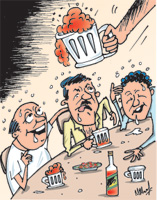Across the world and across time, people have consumed alcohol. But what they drink, why they drink, how and when they drink, who is urged to drink, and who is forbidden to drink – all these aspects of drinking are regulated by local custom, law, and belief.
There may be no one better equipped to tell the story of alcohol use in Sri Lanka than Diyanath Samarasinghe. Dr. Samarasinghe, a member of the Faculty of Medicine of the University of Colombo, has been a leader in addressing alcohol, drugs, and tobacco problems for decades. He has also been a leader and innovator in community- based mental health in Sri Lanka.
Samarasinghe’s well-received book, Alcohol and Poverty (with Bergljot Baklien, 2003) remains a crucial resource for social scientists.
Oh, Go On – Have One More is neither a sociological study of drinking nor a self-help book. Dr. Samarasinghe invites readers -- whether we are abstainers, habitual heavy drinkers, or somewhere in between – to reflect on how we live in the presence of alcohol. The book contains three chapters. The first two chapters invite us to ponder how the symbols, rituals, and customs associated with alcohol serve to shape and limit social occasions, as well as personal identities. In Sri Lanka, as elsewhere, alcohol plays a significant role in cultural meaning making.
Drinking, Dr. Samarasinghe perceptively reminds us, is never truly solitary. Even when people drink in solitude, they drink in accord with social custom and for culturally prescribed reasons. Dr. Samarasinghe invites readers to decode the unwritten rules that govern drinking on social occasions. For example, why is it polite to cajole someone to drink more, but offensive to suggest that someone drink less?
Pressures to drink more come from a number of sources, including self-appointed “alcohol authorities” in drinking settings and manufacturers who relentlessly market their products. In keeping with his insistence that drinking is a shared social practice, Dr. Samarasinghe asks us to tote up the pluses and minuses of heavy drinking not only for the drinkers, but also for others, including those who might be targets of boorish behavior, violent outbursts, or vehicle accidents.
The second essay, “Alcohol and Pleasure,” offers readers a glimpse of Dr. Samarasinghe’s knowledge of physiology, brain chemistry and experimental psychology. Pleasurable experiences, in his view, are nothing if not various. There are intrinsic visceral pleasures, but most of the time, pleasurable experiences are mediated by learning and social meaning.
Few people relish their first taste of caviar; few enjoy their first opera. Paradoxically, some painful experiences -- like eating spicy hot food -- are pleasurable. Laboratory investigations have shown the pleasure that drinkers feel is not a physiological response to ethyl alcohol. Instead, the jollity and high spirits of drinking sessions are the result of expectations and group contagion.
The third essay, “Alcohol and Poverty,” draws on Dr. Samarasinghe’s extensive investigations of rural communities. Dismissing the usual clichés about poverty and drink, the essay begins to explore the everyday realities that promote overconsumption of and overspending on alcohol in poor communities. Dr. Samarasinghe shows how social custom and cultural symbolism, rather than physiological addiction, govern overspending on alcohol.
Buying rounds of drinks, for example, is an important means of preserving face and bolstering one’s status. Moreover, families feel obligated to provide prodigious amounts of alcohol at ritual occasions like weddings. Setting aside simplistic syllogisms about the link between poverty and alcohol consumption, this essay opens space in which new possibilities for change can be imagined.
Who would benefit from reading this book? Everyone who lives in the presence of alcohol. In other words, pretty much all of us.
Diyanath Samarasinghe writes with a light touch; he packages his thought-provoking ideas in graceful, engaging and whimsical prose. By bringing to light what usually passes unseen, he aims to loosen the grip of social pressures and culture custom. Samarasinghe is not a prohibitionist, an alarmist, a doomsayer, or a killjoy.
His goal is not to get people to stop drinking, but to expand the range of drinking choices available to people.
(The reviewer is a professor at Swathmore College, Pennsylvania, USA) |

